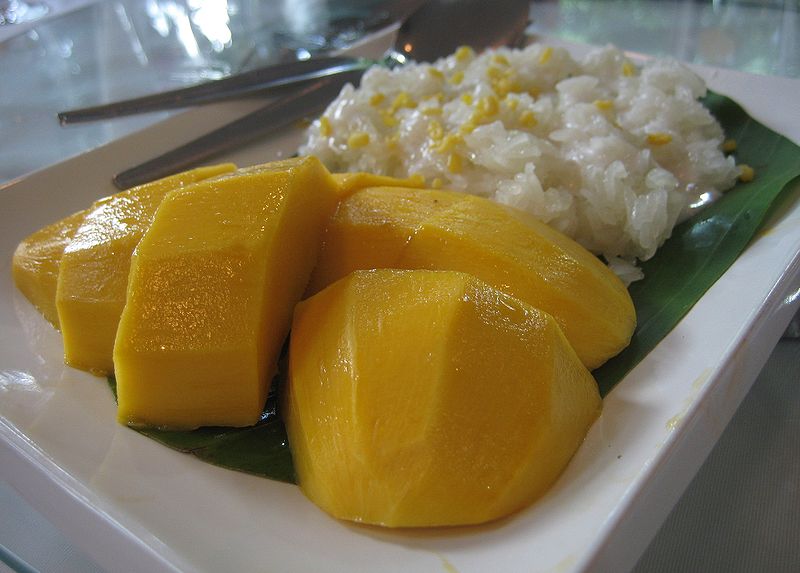Glutinous rice (Oryza sativa var. glutinosa)

Glutinous rice (Oryza sativa var. glutinosa or Oryza glutinosa) is also known as sticky rice, sweet rice, waxy rice, botan rice, biroin chal, mochi rice, and pearl rice. It is called nuomi in Chinese, pulut (Malaysia), mochigome (Japan), chapssal (Korea), khao niao (Laos and Thailand), gao nep (Vietnam), malagkit (Philippines) and kao hnyin (Myanmar). Glutinous rice is a short-grained Asian rice that is sticky when cooked.
Glutinous rice is grown in China, Japan, Korea, Philippines, Thailand, Laos, Indonesia and Vietnam. It does not contain dietary gluten (glutenin and gliadin), and should be safe for gluten-free diets. Glutinous rice contains high amounts of amylopectin and no amylose. Amylopectin is resposible for the sticky quality of the rice.
Glutinous rice can be used either milled or unmilled ( with the bran removed or not removed). Milled rice is white in color, whereas the bran can give unmilled glutinous rice a purple or black color. However black and purple glutinous rice are distinct strains from white glutinous rice. Both black and white glutinous rice can be cooked as grains or ground into flour and cooked as a paste.
Nian gao
 http://commons.wikimedia.org/wiki/File:Nian_gao_nin_gou.jpg
http://commons.wikimedia.org/wiki/File:Nian_gao_nin_gou.jpg
 Juliana Phang
Juliana Phang

Htamanè - Myanmar
 http://commons.wikimedia.org/wiki/File:Htaman%C3%A8.JPG
http://commons.wikimedia.org/wiki/File:Htaman%C3%A8.JPG
 Wagaung
Wagaung

 Thai mango with steamed glutinous rice
Thai mango with steamed glutinous rice
 http://commons.wikimedia.org/wiki/File:Mango_with_glutinous_rice_.jpg
http://commons.wikimedia.org/wiki/File:Mango_with_glutinous_rice_.jpg
 Terence Ong
Terence Ong

Korean rice cakes
 http://commons.wikimedia.org/wiki/File:Korean_rice_cake-Kkaegyeongdan-01.jpg
http://commons.wikimedia.org/wiki/File:Korean_rice_cake-Kkaegyeongdan-01.jpg
 Nicole Cho
Nicole Cho

Traditional Japanese confectionery
 http://commons.wikimedia.org/wiki/File:Kanten_Korimochi.JPG
http://commons.wikimedia.org/wiki/File:Kanten_Korimochi.JPG
 Nightshadow28
Nightshadow28

Nyukcung (zongzi)
 http://commons.wikimedia.org/wiki/File:Nyukcung3.JPG
http://commons.wikimedia.org/wiki/File:Nyukcung3.JPG
 Taman Renyah
Taman Renyah

Glutinous rice is grown in China, Japan, Korea, Philippines, Thailand, Laos, Indonesia and Vietnam. It does not contain dietary gluten (glutenin and gliadin), and should be safe for gluten-free diets. Glutinous rice contains high amounts of amylopectin and no amylose. Amylopectin is resposible for the sticky quality of the rice.
Glutinous rice can be used either milled or unmilled ( with the bran removed or not removed). Milled rice is white in color, whereas the bran can give unmilled glutinous rice a purple or black color. However black and purple glutinous rice are distinct strains from white glutinous rice. Both black and white glutinous rice can be cooked as grains or ground into flour and cooked as a paste.
Nian gao
 http://commons.wikimedia.org/wiki/File:Nian_gao_nin_gou.jpg
http://commons.wikimedia.org/wiki/File:Nian_gao_nin_gou.jpg Juliana Phang
Juliana Phang
Htamanè - Myanmar
 http://commons.wikimedia.org/wiki/File:Htaman%C3%A8.JPG
http://commons.wikimedia.org/wiki/File:Htaman%C3%A8.JPG Wagaung
Wagaung
 Thai mango with steamed glutinous rice
Thai mango with steamed glutinous rice http://commons.wikimedia.org/wiki/File:Mango_with_glutinous_rice_.jpg
http://commons.wikimedia.org/wiki/File:Mango_with_glutinous_rice_.jpg Terence Ong
Terence Ong
Korean rice cakes
 http://commons.wikimedia.org/wiki/File:Korean_rice_cake-Kkaegyeongdan-01.jpg
http://commons.wikimedia.org/wiki/File:Korean_rice_cake-Kkaegyeongdan-01.jpg Nicole Cho
Nicole Cho
Traditional Japanese confectionery
 http://commons.wikimedia.org/wiki/File:Kanten_Korimochi.JPG
http://commons.wikimedia.org/wiki/File:Kanten_Korimochi.JPG Nightshadow28
Nightshadow28
Nyukcung (zongzi)
 http://commons.wikimedia.org/wiki/File:Nyukcung3.JPG
http://commons.wikimedia.org/wiki/File:Nyukcung3.JPG Taman Renyah
Taman Renyah
 Index of 690
Plants in The Flowering Garden
Index of 690
Plants in The Flowering Garden
Copyright © 2008-2018 The Flowering Garden. All Rights Reserved.